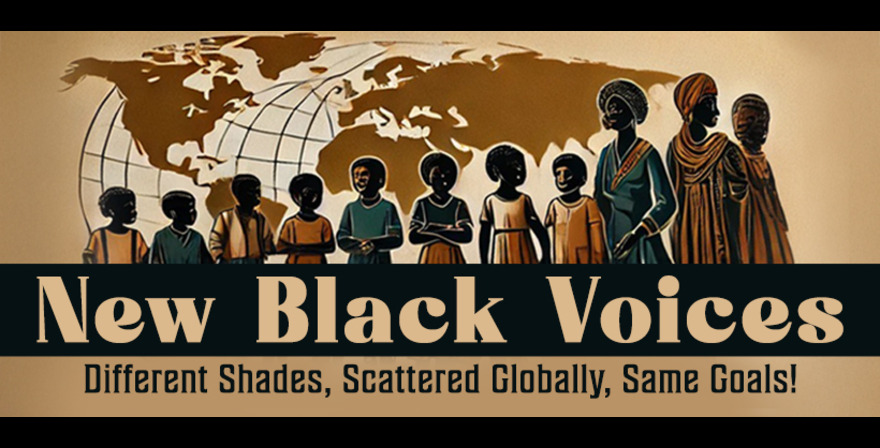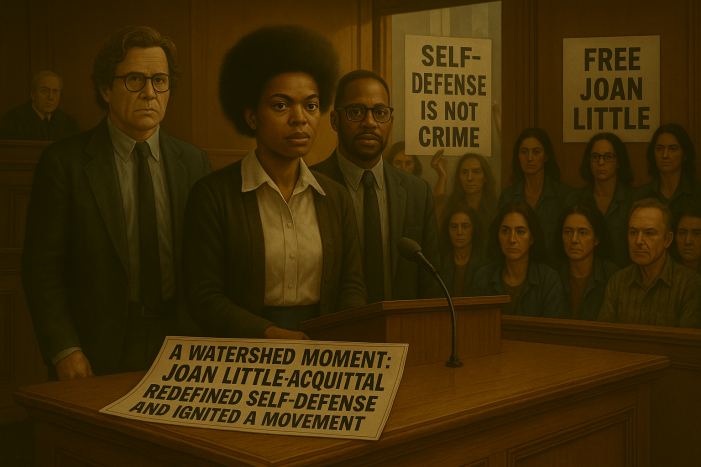By Esther Claudette Gittens | Photo by: AI
In the turbulent summer of 1975, a North Carolina courtroom became the epicenter of a case that would forever alter the American legal landscape and galvanize nascent movements for racial and gender equality. Joan Little, a young Black woman incarcerated for breaking and entering, faced the death penalty for the killing of Clarence Alligood, a white jailer. Her defense was audacious and unprecedented: she claimed Alligood had attempted to sexually assault her with an ice pick, and she had used deadly force to save her own life. On August 15, 1975, a jury, in a decision that reverberated across the nation, found Joan Little not guilty. This landmark verdict marked the first time in U.S. history that a woman was acquitted of murder for using deadly force to resist sexual assault, solidifying Little’s place as a symbol of strength, resilience, and the fight for justice.
The Joan Little case did not unfold in a vacuum. The early 1970s were a period of profound social and political upheaval. The Civil Rights Movement had achieved significant legislative victories but continued to battle deeply entrenched systemic racism, particularly within the criminal justice system. Simultaneously, the feminist movement was gaining momentum, challenging patriarchal norms and demanding bodily autonomy and an end to gender-based violence. Little’s plight resonated deeply within these movements, her identity as a Black woman confronting the dual oppressions of racism and sexism making her a potent symbol.
The Incident and the Indictment: A Narrative of Power and Resistance
The events of August 27, 1974, in the Beaufort County Jail were, at their core, a brutal illustration of the power dynamics at play. Little, then 20 years old, alleged that the 62-year-old Alligood, the night jailer, entered her cell, made sexual advances, and threatened her with an ice pick. In the ensuing struggle, Alligood was killed with the same ice pick, and Little fled. When she surrendered to authorities over a week later, she was charged with first-degree murder, a capital offense in North Carolina.
The prosecution painted Little as a manipulative and violent woman who had lured Alligood into her cell to facilitate her escape. This narrative played into historical and damaging stereotypes of Black women as inherently promiscuous and deceitful. Conversely, Little’s defense team, led by Jerry Paul and Karen Galloway (the first Black woman to be a lead counsel in a major Southern trial), argued that she was a victim of a violent sexual predator, forced to defend her life in a terrifying encounter. They highlighted Alligood’s history of alleged sexual misconduct with other female inmates, lending credence to Little’s account.
A Cause Célèbre: Mobilizing for Justice
Joan Little’s case quickly transcended the confines of a typical criminal trial. It became a cause célèbre, attracting national and international attention and support from a broad coalition of civil rights organizations, feminist groups, anti-death penalty advocates, and prison reformers. Groups like the Southern Poverty Law Center, the NAACP, the National Organization for Women, and various grassroots activists rallied to her defense, recognizing the profound implications of her case.
Fundraising efforts, public demonstrations, and extensive media coverage amplified Little’s story. Activists understood that her trial was not merely about one woman’s guilt or innocence; it was a referendum on the value of Black women’s lives, the right to self-defense against sexual violence, and the pervasive injustices within the carceral system. The “Free Joan Little” movement became a powerful rallying cry, highlighting the intersectionality of her struggle. As civil rights icon Angela Davis, a vocal supporter, articulated, Little’s case exposed the ways in which Black women were uniquely vulnerable to state-sanctioned violence and a legal system that often failed to protect them.
The Trial: Challenging Legal and Social Norms
The trial itself, which was moved from conservative Beaufort County to Raleigh to ensure a fairer hearing, was a five-week crucible. The defense meticulously built a case that not only detailed the events of that fateful night but also educated the jury and the public about the psychological trauma of sexual assault and the desperate measures a person might take to survive. They employed innovative legal strategies, including the use of expert testimony on the impact of sexual violence and the then-nascent field of scientific jury selection to counter potential biases.
The prosecution, reliant on circumstantial evidence and character attacks, struggled to overcome the compelling narrative of self-defense, particularly in the face of evidence suggesting Alligood was undressed from the waist down and semen was found on his leg – facts that corroborated Little’s claim of a sexual motive.
The jury, composed of six Black and six white members, deliberated for a remarkably short 78 minutes before returning a verdict of not guilty. The swiftness and unanimity of the decision underscored the power of Little’s testimony and the strength of her defense.
The Impact and Legacy: A Shift in the Legal and Social Landscape
Joan Little’s acquittal was a monumental victory with far-reaching consequences. Legally, it was a groundbreaking moment that helped to legitimize the use of deadly force in self-defense against rape. While self-defense had long been a recognized legal principle, its application in cases of sexual assault, particularly when asserted by women (and especially Black women), was often met with skepticism or outright dismissal. Little’s case forced a re-evaluation of these biases within the legal system. It provided a crucial precedent that empowered other victims of sexual violence to assert their right to self-preservation.
Socially and politically, the case was a watershed. It brought the often-silenced issue of sexual violence against incarcerated women to the forefront of public discourse. It highlighted the particular vulnerability of Black women within a justice system frequently marred by racial and gender bias. The broad-based movement that coalesced around Joan Little demonstrated the power of intersectional activism, uniting diverse groups under a common cause for justice.
Moreover, Little’s bravery in the face of overwhelming power, her unwavering assertion of her truth, transformed her into an enduring symbol of resistance. She represented the courage to fight back, not only against an individual attacker but also against an oppressive system. Her case served as an indictment of the historical devaluation of Black women’s lives and their testimony.
While Joan Little herself largely retreated from public life in the years following the trial, the impact of her case continued to resonate. It spurred further activism around prison reform, the rights of sexual assault survivors, and the fight against racial injustice. Legal scholars and activists continue to cite her case as a critical juncture in the evolution of self-defense law and the ongoing struggle for gender and racial equality.
An Enduring Symbol of Strength and Justice
More than just a historical footnote, the Joan Little case remains a powerful testament to the courage of one woman and the collective power of a movement demanding justice. Her acquittal was not merely a legal victory; it was a profound moral statement that a woman’s life and bodily integrity are worth defending, regardless of her race or circumstances. In a society still grappling with the pervasive issues of sexual violence and systemic inequality, Joan Little’s story serves as a vital reminder of the ongoing fight for true justice and the enduring strength found in acts of self-preservation and collective action. Her legacy continues to inspire those who challenge injustice and advocate for a world where every individual can live free from the threat of violence and oppression.

